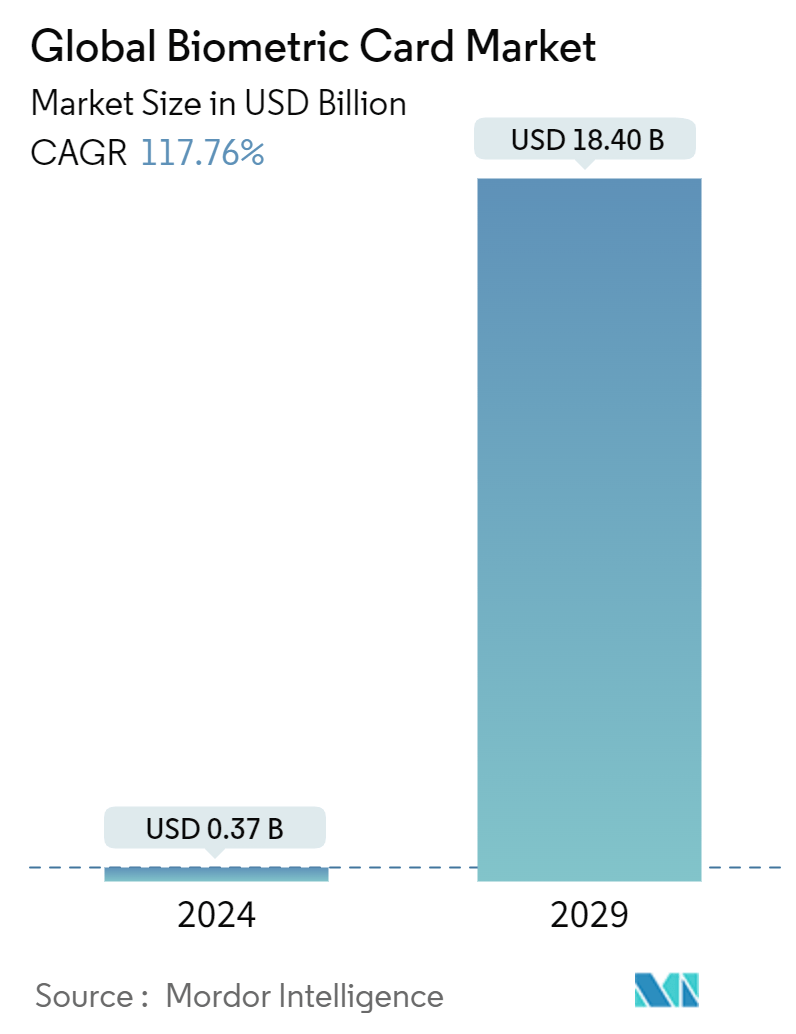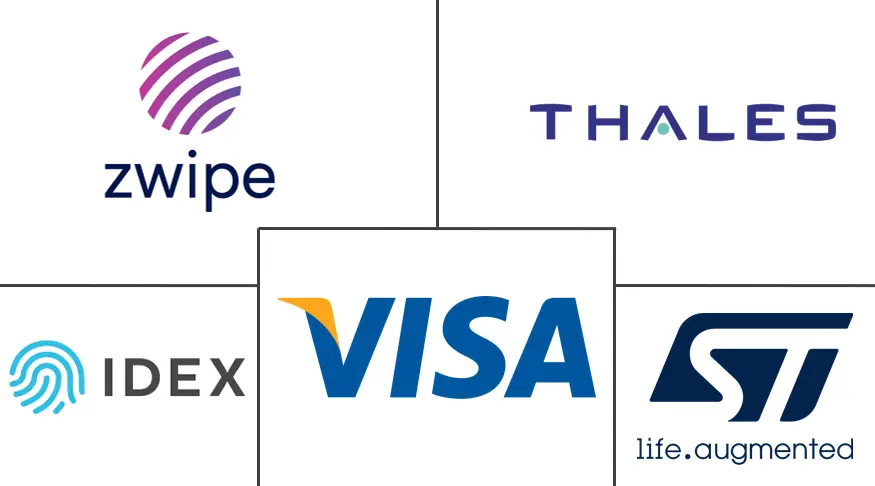Market Size of Global Biometric Card Industry

| Study Period | 2019 - 2029 |
| Market Size (2024) | USD 0.37 Billion |
| Market Size (2029) | USD 18.40 Billion |
| CAGR (2024 - 2029) | 117.76 % |
| Fastest Growing Market | Asia-Pacific |
| Largest Market | North America |
Major Players
*Disclaimer: Major Players sorted in no particular order |
Biometric Card Market Analysis
The Global Biometric Card Market size is estimated at USD 0.37 billion in 2024, and is expected to reach USD 18.40 billion by 2029, growing at a CAGR of 117.76% during the forecast period (2024-2029).
- Biometric Authentication Revolutionizing Payment Security: The Biometric Card Market is witnessing significant growth as demand for secure and convenient payment methods rises. Biometric cards, incorporating fingerprint sensors or other biometric technologies, are revolutionizing the financial industry by addressing payment fraud concerns while improving user experience.
- Secure transactions: Biometric cards integrate fingerprint recognition with smart card technology to ensure secure payments.
- Ecosystem partnerships: A surge in collaborations among players in the ecosystem is driving the market forward.
- Major certifications: Mastercard, Visa, and China UnionPay are leading the way in certifying biometric card solutions.
- Financial Inclusion Driving Market Expansion: A key driver of the biometric card market is the demand from financial inclusion initiatives, particularly in emerging markets. Governments and financial institutions are adopting biometric technologies to integrate unbanked populations into the financial system, creating new growth opportunities.
- African initiatives: Mastercard and Paycode aim to enroll 30 million Africans in a biometric smart card financial inclusion program.
- Brazilian potential: Brazil shows high potential, with digital banks like Desty focusing on underserved populations.
- Global trials: Biometric card trials are ongoing in countries like Poland, Iraq, India, Mexico, Lebanon, and Egypt.
- Multi-Factor Authentication Boosting Market Growth: The growing adoption of multi-factor authentication (MFA) is a major factor fueling the biometric card market. As cybersecurity threats evolve, businesses and consumers are integrating MFA solutions that incorporate biometrics for enhanced security.
- Integration in MFA: Biometric authentication is becoming a key element of MFA systems.
- Healthcare adoption: The healthcare sector is embracing MFA to protect patient data.
- Ecommerce surge: The rise of mobile banking and ecommerce is increasing the demand for strong authentication.
- Competitive Landscape and Strategic Initiatives: The biometric card market is highly competitive, with strategic collaborations and innovations defining market dynamics. Leading players are focusing on technological advancements and certifications to strengthen their market positions.
- Thales Group leadership: Thales is at the forefront with over 20 biometric payment card projects.
- Partnerships for expansion: Companies like Zwipe, Idemia Group, and Fingerprint Cards AB are expanding their global reach by partnering with regional players.
- Innovation push: Major financial platforms are driving the adoption of secure, innovative technologies.
- Future Outlook and Market Potential: The future of the biometric card market looks promising, with emerging trends indicating sustained growth. The integration of biometrics with IoT and smart city initiatives is unlocking new opportunities beyond traditional payments.
- Multimodal biometrics: The market is evolving towards multimodal solutions, combining fingerprint, facial recognition, and hand geometry.
- Contactless payments: Contactless biometric payment cards are gaining popularity due to their security and convenience.
- Cryptocurrency integration: The use of biometric cards in cryptocurrency transactions is an emerging trend.
Biometric Card Industry Segmentation
A biometric card combines embedded chip technology with fingerprint authentication technologies. It is used to verify a cardholder’s identity for in-store purchases.
The biometric card market is segmented by application (payments, access control, government id, financial inclusion), end-user vertical (BFSI, retail, government, healthcare, commercial entities), and geography (North America, Europe, Asia-Pacific, rest of the World). The Market Sizes and Forecasts are Provided in Terms of Value (USD) for all the Above Segments.
| By Application | |
| Payments | |
| Access Control | |
| Government ID and Financial Inclusion | |
| Other Applications |
| By End-User Vertical | |
| BFSI | |
| Retail | |
| Government | |
| Healthcare | |
| Commercial Entities | |
| Other End-user Verticals |
| By Geography | |
| North America | |
| Europe | |
| Asia Pacific | |
| Rest of the World |
Global Biometric Card Market Size Summary
The biometric card market is poised for significant expansion, driven by the increasing demand for secure authentication systems across various sectors such as banking, retail, gaming, and security. These cards integrate advanced biometric technologies, including fingerprint, iris, and facial recognition, with embedded chip technology to enhance security during transactions. Unlike traditional payment methods, biometric cards offer a higher level of security by verifying the cardholder's identity through unique physical traits, thereby reducing the risk of fraud. The market is witnessing a surge in interest due to the growing need for contactless payment solutions, especially in the wake of the COVID-19 pandemic, which has accelerated the adoption of contactless technologies.
The market landscape is characterized by intense competition among key players like Zwipe AS, Thales Group, IDEX Biometrics, and STMicroelectronics, who are actively investing in new product developments and strategic collaborations to capture a larger market share. The Asia-Pacific region, with its robust payment card infrastructure, is a focal point for market growth, as companies strive to integrate biometric technology into their offerings. Despite the higher costs associated with biometric cards, the potential for enhanced security and convenience is driving interest from both consumers and businesses. As the market evolves, partnerships and technological advancements are expected to play a crucial role in expanding the adoption of biometric cards globally.
Global Biometric Card Market Size - Table of Contents
-
1. MARKET INSIGHTS
-
1.1 Market Overview
-
1.2 Industry Attractiveness - Porter's Five Forces Analysis
-
1.2.1 Bargaining Power of Suppliers
-
1.2.2 Bargaining Power of Buyers
-
1.2.3 Threat of New Entrants
-
1.2.4 Threat of Substitutes
-
1.2.5 Intensity of Competitive Rivalry
-
-
1.3 Assessment of Impact of COVID-19 on the Market
-
1.4 Industry Ecosystem Analysis
-
1.5 Evolution of Biometric Cards
-
-
2. MARKET SEGMENTATION
-
2.1 By Application
-
2.1.1 Payments
-
2.1.2 Access Control
-
2.1.3 Government ID and Financial Inclusion
-
2.1.4 Other Applications
-
-
2.2 By End-User Vertical
-
2.2.1 BFSI
-
2.2.2 Retail
-
2.2.3 Government
-
2.2.4 Healthcare
-
2.2.5 Commercial Entities
-
2.2.6 Other End-user Verticals
-
-
2.3 By Geography
-
2.3.1 North America
-
2.3.2 Europe
-
2.3.3 Asia Pacific
-
2.3.4 Rest of the World
-
-
Global Biometric Card Market Size FAQs
How big is the Global Biometric Card Market?
The Global Biometric Card Market size is expected to reach USD 0.37 billion in 2024 and grow at a CAGR of 117.76% to reach USD 18.40 billion by 2029.
What is the current Global Biometric Card Market size?
In 2024, the Global Biometric Card Market size is expected to reach USD 0.37 billion.

